In January, 2015, I was privileged to see the exhibit Retablos de mi Pueblo, sculptural works by Edwin Báez Carrasquillo. These constructions, usually set up as wall reliefs, are classified in Puerto Rico as works of "artesanía," thus craft (rather than "art"). But this categorization would mean that we would also have to see Judy Chicago's "Dinner Party," also displayed in a dim, almost sacred atmosphere, also using various media, as something less than real painting or sculpture or architecture. Báez' works, it is true, are miniatures but with a powerful impact.
The title of the exhibit is suggestive. Although these are secular works, the word "retablo" connects these sculptures with devotional religious art, the retablos (paintings or sculptures), featuring the Virgin or Jesus or numerous saints, which have prominent locations in churches. Edwin Báez honors a number of Puerto Rican secular saints and heroes in these works--and when they are not the historical grand persons, they are local heroes or anonymous Puerto Ricans that are featured for their values or cultural authenticity. He records historical events as well as reactions by his countrymen and women to natural events, like hurricanes.
The craftsmanship in these works is amazing. Made of carved wood, or clay, or other materials, the details are meticulously crafted and painted; environments are fully embellished--walls with pictures, posters, or calendars; shelves with books, implements, artifacts; tables, chairs, ladders, doors, and musical instruments--tiny dollhouse elements to flesh out his themes. Animals recur, whether cats and dogs, or horses, or bats and a variety of birds. The profusion of details merits a long examination. Then some wall reliefs spill out of the frame, some occupying a larger part of the wall or some move to the floor becoming installations.
I am grateful to the Museum of the Americas for hosting this remarkable exhibit.
|
Isla Nena, (or Infant Island), 2002According to the labeling at the museum, the setting here is Vieques (also know as Isla Nena) before the US Navy left. It shows a young boy confused by the noise from the constant military exercises on his land. He only wants to live in peace and clings to his flag and his culture.
|
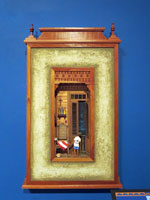 |
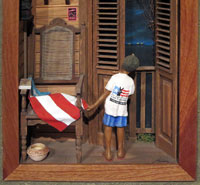 |
The clay pot represents the earlier indigenous culture in Vieques and the novel USMail by Pedro Juan Soto underlines the importance of Vieques in Puerto Rico's literary tradition. |
| |
|
Taller Común, 2004Although the mural represented in this retablo no longer exists, the sculpture records the painting of a mural in la Plaza de las Artes de Cagua. Although eight painters worked on it, Báez shows two of them, Orlando Vallejo y Héctor Escalante, one at each end. |
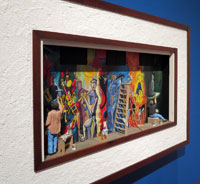 |
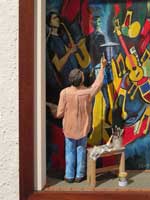 |
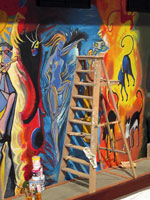 |
| |
|
Adolfina, 2007 This retablo represents Adolfina Villanueva standing in front of her humble home in Medianía Alta, Loíza Aldea, refusing to be evicted. We can imagine that minutes later, this wife of a fisherman and mother of six will be gunned down by the police in a land appropriation event (February 6, 1980). The site of the house where her children were born was the only lot not developed after this land was appropriated. |
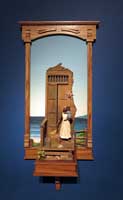 |
| |
|
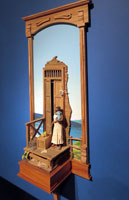 |
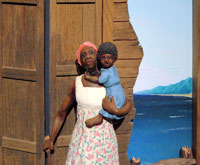 |
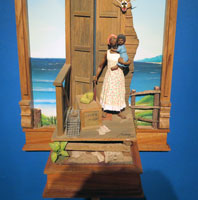 |
| |
|
Don Pablo y las Palomas, 2007Here Pablo Casals, one of the greatest cellists of all time, plays his instrument. Although Casals was born in Spain, his mother was Puerto Rican, and during the Franco era, he moved to Puerto Rico where he founded the Festival Casals in 1957 and later Puerto Rico's symphony orchestra and a Conservatory of Music there.
|
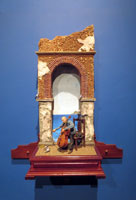 |
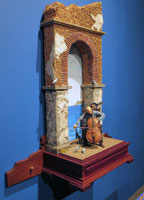 |
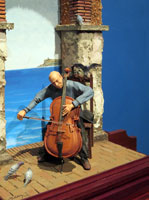 |
| |
|
El Pintor y el Santero, 2008This retablo depicts an imaginary meeting between the painter Rafael Tufiño and the santero (a painter/sculptor who makes hand-carved statues of saints) Zoilo Cajigas Sotomayor. |
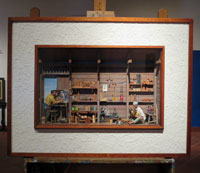 |
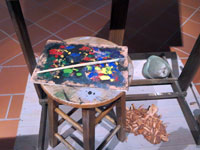 |
| |
|
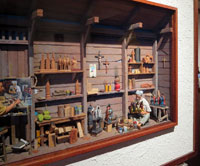 |
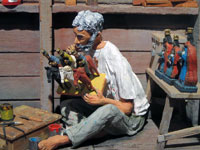 |
His simple studio is filled with partly finished and completed works; he is painting figures of the three magi. Bare-footed and wearing a wooden cross around his neck, the artist exudes piety and humility. |
| |
|
Los Renegados, 2010This retable is based on the short story "Los Renegados" by Dr. Ricardo E. Alegría, revered Puerto Rican historian, archeologist, and cultural anthropologist who founded the Museum of the Americas in 1992. In this short story, Dr. Alegría explores popular Puerto Rican beliefs about the origins of bats. In the story, the devil responds to the envy of the mice who want to fly like birds, by stretching their skin to make wings--thus they are bats, but still rejected by members of the bird kingdom. This is the subject of the central panel. |
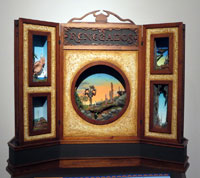 |
| |
|
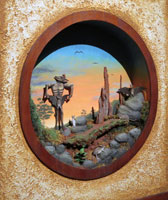 |
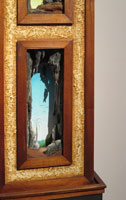 |
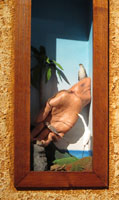 |


 Click here to return to index of art historical sites.
Click here to return to index of art historical sites.
 Click here to return to index of artists and architects.
Click here to return to index of artists and architects.
 Click here to return to chronological index.
Click here to return to chronological index.
 Click here to see the home page of Bluffton University.
Click here to see the home page of Bluffton University.

